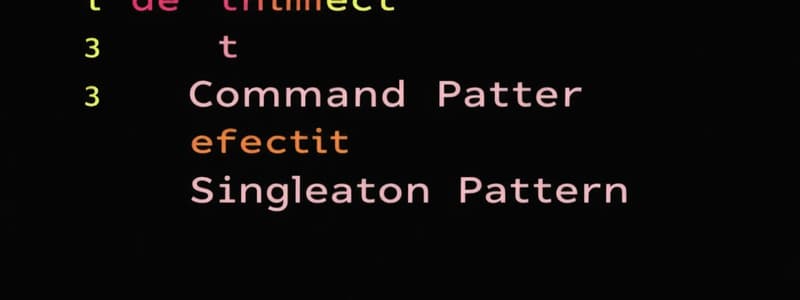Podcast
Questions and Answers
In the Command pattern, what is the primary purpose of encapsulating actions into objects?
In the Command pattern, what is the primary purpose of encapsulating actions into objects?
- To simplify the user interface design.
- To improve the performance of the application by caching results.
- To reduce the number of classes in the application.
- To allow actions to be passed as parameters, queued, and logged. (correct)
In the context of the Command pattern, what role does the 'Invoker' play?
In the context of the Command pattern, what role does the 'Invoker' play?
- It holds and triggers the command to execute at a specific time. (correct)
- It defines the interface for all command objects.
- It creates the command object and sets its parameters.
- It executes the command directly.
Within the Command pattern, what is the responsibility of the 'Receiver'?
Within the Command pattern, what is the responsibility of the 'Receiver'?
- To define the interface for executing commands.
- To create command objects.
- To perform the actual operation when the command is executed. (correct)
- To manage the command queue.
Consider a scenario where multiple UI buttons in an application perform similar actions, like saving a document, but on different file types. How could the Command pattern be utilized effectively?
Consider a scenario where multiple UI buttons in an application perform similar actions, like saving a document, but on different file types. How could the Command pattern be utilized effectively?
In a text editor application, which component would most appropriately be the 'Receiver' in a Command pattern implementation for text formatting operations?
In a text editor application, which component would most appropriately be the 'Receiver' in a Command pattern implementation for text formatting operations?
What is the main goal of the Singleton pattern?
What is the main goal of the Singleton pattern?
Which of the following is a crucial characteristic of a Singleton class?
Which of the following is a crucial characteristic of a Singleton class?
Why is the Singleton pattern often considered an anti-pattern in certain contexts?
Why is the Singleton pattern often considered an anti-pattern in certain contexts?
In a multi-threaded environment, what is a key consideration when implementing the Singleton pattern?
In a multi-threaded environment, what is a key consideration when implementing the Singleton pattern?
Consider a system that requires a single point of access to a configuration manager. How would you ensure that only one instance of the ConfigurationManager class exists?
Consider a system that requires a single point of access to a configuration manager. How would you ensure that only one instance of the ConfigurationManager class exists?
Which of the following best describes the relationship between the 'Action' interface and 'ActionListener' in the Swing framework, as it relates to the Command pattern?
Which of the following best describes the relationship between the 'Action' interface and 'ActionListener' in the Swing framework, as it relates to the Command pattern?
What is the primary advantage of using the 'Action' interface in Swing for handling UI events?
What is the primary advantage of using the 'Action' interface in Swing for handling UI events?
In the context of Swing, how does associating an 'Action' with a component (like a JButton) affect the component's state?
In the context of Swing, how does associating an 'Action' with a component (like a JButton) affect the component's state?
Which of the following scenarios best illustrates the use of the Command pattern in a GUI application?
Which of the following scenarios best illustrates the use of the Command pattern in a GUI application?
What problem does the Command pattern solve in the context of UI design with components like buttons?
What problem does the Command pattern solve in the context of UI design with components like buttons?
What is the role of the execute() method in the Command pattern?
What is the role of the execute() method in the Command pattern?
In an application using the Command pattern, how would you implement a macro (a series of commands executed in sequence)?
In an application using the Command pattern, how would you implement a macro (a series of commands executed in sequence)?
What is the significance of the private constructor in the Singleton pattern?
What is the significance of the private constructor in the Singleton pattern?
How does the Singleton pattern help in reducing global variables?
How does the Singleton pattern help in reducing global variables?
When using the Singleton pattern, what is the purpose of the static getInstance() method?
When using the Singleton pattern, what is the purpose of the static getInstance() method?
What is the primary benefit of having a single instance of a spooler (print queue) in a system, which is often implemented using the Singleton pattern?
What is the primary benefit of having a single instance of a spooler (print queue) in a system, which is often implemented using the Singleton pattern?
In the given code snippet for the SingleRandom class, what is the purpose of the setSeed(int seed) method?
In the given code snippet for the SingleRandom class, what is the purpose of the setSeed(int seed) method?
What is a potential disadvantage of using the Singleton pattern excessively in an application?
What is a potential disadvantage of using the Singleton pattern excessively in an application?
If a class uses only static methods and cannot be instantiated, such as the Math class in Java, can it be considered a Singleton?
If a class uses only static methods and cannot be instantiated, such as the Math class in Java, can it be considered a Singleton?
What is the purpose of the Java Runtime class?
What is the purpose of the Java Runtime class?
In the context of the Command pattern, which participant is responsible for storing and executing the commands?
In the context of the Command pattern, which participant is responsible for storing and executing the commands?
Which of the following represents a real-world analogy for the Command pattern?
Which of the following represents a real-world analogy for the Command pattern?
In the Singleton pattern, which element is primarily in charge of ensuring the uniqueness of the instance?
In the Singleton pattern, which element is primarily in charge of ensuring the uniqueness of the instance?
Which of the following is NOT an advantage commonly associated with the Singleton pattern?
Which of the following is NOT an advantage commonly associated with the Singleton pattern?
In a text editor application, 'Cut', 'Copy', and 'Paste' operations can be effectively implemented using which design pattern?
In a text editor application, 'Cut', 'Copy', and 'Paste' operations can be effectively implemented using which design pattern?
Consider a scenario where you need to implement a logging mechanism in an application. Why might the Singleton pattern be a suitable choice for managing the logger?
Consider a scenario where you need to implement a logging mechanism in an application. Why might the Singleton pattern be a suitable choice for managing the logger?
How does the Command pattern support the "Open/Closed Principle" (a class should be open for extension but closed for modification)?
How does the Command pattern support the "Open/Closed Principle" (a class should be open for extension but closed for modification)?
Which scenario exemplifies a suitable use case for the Singleton pattern?
Which scenario exemplifies a suitable use case for the Singleton pattern?
How does the Command Pattern improve testability in software systems?
How does the Command Pattern improve testability in software systems?
Flashcards
Command Pattern
Command Pattern
Encapsulates actions as objects, decoupling the invoker from the receiver.
Command Interface
Command Interface
Defines an interface with an execute() method for running a command.
Concrete Command
Concrete Command
A class representing a specific action implementing the Command interface.
Invoker
Invoker
Signup and view all the flashcards
Receiver
Receiver
Signup and view all the flashcards
Advantage of Command Pattern
Advantage of Command Pattern
Signup and view all the flashcards
Singleton Pattern
Singleton Pattern
Signup and view all the flashcards
Purpose of Singleton
Purpose of Singleton
Signup and view all the flashcards
Implementation of Singleton
Implementation of Singleton
Signup and view all the flashcards
Advantages of Singleton
Advantages of Singleton
Signup and view all the flashcards
Runtime Class (Java)
Runtime Class (Java)
Signup and view all the flashcards
Study Notes
Command Pattern and Singleton
- LOG121 presents the Command and Singleton design patterns, instructed by Souad Hadjres
Plan
- The presentation will cover the Command Pattern and the Singleton Pattern
Design Problem Example
- The Swing framework offers graphical objects such as buttons
- These graphical objects emit requests when a user interacts with them
- Swing's designers didn't know which objects would receive the request or how it would be executed
- Applications using Swing know which request is emitted and which object should react to it
Command Pattern Example
- Shows a simple application with buttons "Ouvrir" (Open) and "Quitter" (Quit)
- ActionListener interface is implemented by the Application class
- The AbstractButton class has an addActionListener method to which the Application can subscribe
Sample Code
- Java code is used to demonstrate how Swing buttons trigger actions through the ActionListener interface
Design Problem
- The actionPerformed method in the example application is not very practical and can quickly become complex
- The application may end up with many methods and too many responsibilities
- The same action can be executed in different ways (e.g., from a button, a menu item)
- Actions may not be permissible in certain contexts
- For example, "paste" without having "copied" or "cut"
- Indicates how Swing’s designers addressed these issues
Solution to the Problem
- The Action interface extends ActionListener
- An action can have a name and an associated icon
- An action can be associated with different interface elements
- An action can be activated or deactivated
- One action can declare another action as its opposite
Code Solution
- Code is written so when an action is attached to a component using the setAction method
- The component's state is updated to match the action's state
- The Action object is registered as a listener on the component
- When the action's state changes, the component's state is adjusted accordingly
Solution to the Problem
- Actions to be executed are encapsulated in objects that extend the AbstractAction class
- These objects handle the execution of the actions
- They can be used by multiple graphical components
- States (enabled, disabled) can be associated with them
- G actions managed, composed, and reverted (undo, redo)
- Decouples the source object of the action from the object on which the action is executed
CommandTester Code
- Demonstrates a command tester using GreetingAction extending AbstractAction
The Command Pattern
- Emphasizes the implementation of commands as objects for associating information or tracking for re-execution, undo, or grouping
- Focuses on decoupling the object initiating the command from the one receiving it
Command Pattern Details
- Involves defining a Command interface with a method to execute the command
- The interface defines methods for accessing the command's state
- Each concrete class implements the interface and represents a command
- Invoking the command means calling the execution method
Command Pattern Structure
- Simplified structure highlights the Client and Command interfaces, and the concrete commands without showing the objects being acted upon
Command Pattern Structure
- Full structure used in the course, consists of the Client, Invoker, Command, Receiver, and ConcreteCommand elements
Command Pattern: Roles
- Clarifies the roles within the Command Pattern, in terms of their equivalent in a Swing example
Application Example
- Shows an example of applying the Command Pattern in an application
- Highlights the relationships between the Client, Receiver, Invoker and Commands
Object Interactions
- Client creates a concrete command, specifies its receiver, and configures an invoker with a concrete command
- The invoker calls the Execute method of the ConcreteCommand object
- Concrete command's execute method invokes the receiver object’s operations to fulfill the request
Command Pattern Application
- A calculator application supports basic operations, and also has undo
Code Example
- Example code for command pattern
Implementation Code
- Java code defines the interfaces and classes
- Includes ICommand, Addition, Multiplication, Calculateur (Receiver), and Usager (Invoker) implementing the command pattern for basic calculator operations
Advantages of the Command Pattern
- Helps decouple the object invoking a command from the object that knows how to perform it
- All command objects have a common interface for invocation
- Allows assembling command objects into a composite command
- Helps control their sequencing
- Allows the insertion into queues
- Also allows to implement reversion of operations (Undo and Redo)
Singleton Pattern
- Overview of what is coming next
Design Problem Example: Singleton Pattern
- Many situations require only one instance of a class with global access to it
- Examples include a spooler, an object factory, or a class managing database access
Examples of Problems: Random Number Generation
- Example program which uses multiple classes and needs random numbers to be generated
- Example uses number generation using seeds and a set calculation
- To debug the number generation, the program needs to debug using the same sequence of numbers
Solution
- Ensure there is only one random number generator
- A class is designed with a private constructor and the class provides a static method that returns the instance of the class
The Singleton Pattern
- Ensures a class has only one instance and provides a global point of access to it
Singleton
- Entrusts the class itself with the responsibility of ensuring the uniqueness of its instance
- Class should define a private constructor that returns a reference the instance, only constructing a single instance of itself
- The class controls how and when client classes access it
Singleton Structure
- Shows the structure of a Singleton class with a private uniqueInstance attribute, a private constructor, and a public getInstance() method
Pattern Advantages
- Controlled access to a single instance
- Reduces global variables
- Permits extension to single instance
- Can be adapted for a variable number of instances
Patterns Disadvantages
- Java's Math class defines methods for performing basic numeric operations, and exclusively defines static methods
- The Math class cannot be instantiated and cannot be extended
- Therefore, the pattern is not singleton: rather it groups all the functions together.
Application Example
- Demonstrates the Runtime class as a Singleton class in Java.
Studying That Suits You
Use AI to generate personalized quizzes and flashcards to suit your learning preferences.




